In addition to Gorton Machine, George II had a number of other business ventures
he was involved with. The principal ones were:
- Racine Basket Manufacturing Co.
Not much is known (by this author) about Racine Basket, except that it
appeared to be closely held, and that George Gorton I was a principal
owner.
- Planters Engine Co.
Some sheets of company stationary (with a watermark of "Bond No 25") survive.
Nothing else is known about this venture
- Gorton Gate and Fence Co.
This was a partnership with Joseph Tausch, and the factory was located
in Waukegan, IL. or Winthrop Harbor, IL.
The company was liquidated sometime in 1918 or later.
- The Gorton Trust
Oil Fever affected a lot of people, including George II. In fact,
the family relocated to Cement, Oklahoma for the years 1917 to 1927.
The trust was liquidated in the early 1950s, after many years of litigation.
- Federal Mailing & Machine Co.
George II was involved with the design and construction of a machine which
would automatically fold and wrap printed content. The time period for this
is unknown.
- Miscellaneous projects
 Most of the information about Racine Basket comes from a few paragraphs in
[Port92] about George I, and
various hints from
[GG2mem].
The factory was located on 13th, 14th, Racine, and Clark Streets.
George I bought Racine Basket prior to 1878; after the works were destroyed
by fire in 1878, the factory was rebuilt in brick and stone.
George II worked at various positions with Racine Basket, including as
a traveling (via rail) salesman.
In June, 1888, George I died, with the net effect that George II had to take
over the operation of the Racine Basket Co, which employed roughly 200
people at the time.
A pair of photographs of Racine Basket employees likely exist: This first one is
not a sure thing, but some of the faces do match up with faces in the one that is
a known employee photo.
Most of the information about Racine Basket comes from a few paragraphs in
[Port92] about George I, and
various hints from
[GG2mem].
The factory was located on 13th, 14th, Racine, and Clark Streets.
George I bought Racine Basket prior to 1878; after the works were destroyed
by fire in 1878, the factory was rebuilt in brick and stone.
George II worked at various positions with Racine Basket, including as
a traveling (via rail) salesman.
In June, 1888, George I died, with the net effect that George II had to take
over the operation of the Racine Basket Co, which employed roughly 200
people at the time.
A pair of photographs of Racine Basket employees likely exist: This first one is
not a sure thing, but some of the faces do match up with faces in the one that is
a known employee photo.
The note on the back says "Louis Namp 8/27/58". 1958 seems
odd, and 1858 seems highly unlikely. It may be possible to establish a
"no earlier than" date based upon the type of insulators above the window
on the left.
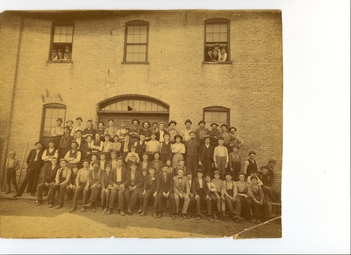
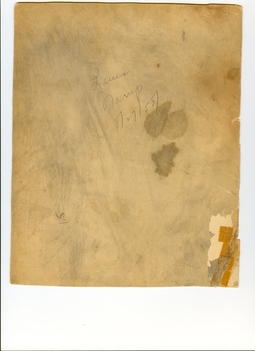
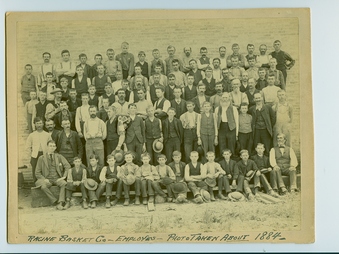
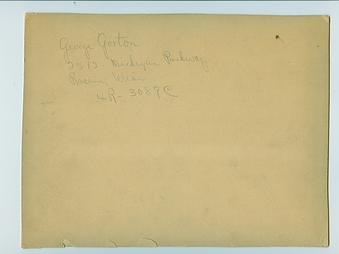
The description of the factory in
[Port92] is of a fairly extensive
facility: a machine room of 60' x 80'; a bending room of 65' x 75'; a
cutting machine room of 112' x 50'; a nailing room of 115' x 50'; a stock room
of 115' x 50'; two shipping rooms at 120' x 80' each; an a storage facility
of 359,000 cubic feet. There was also a "five ton power traveling train
running the full length of the building, so that no time is wasted in handling
the heaviest timbers." The company produced more than 400 different sizes and
styles of baskets, with an average daily output of 15 thousand baskets, not
counting berry boxes.
During the 'season' of 1891, the daily output of the factory was 15 thousand
baskets and 40 thousand berry boxes and crates, with an average work force of 200.
An inventory of for Jan 1892-Jan 1893
still exists (and is held by the Racine Public Library).
A few other details about Racine Basket: A
[RWEb] document (1875/76
Racine Miscellaneous directory pub. Murphy & Co.) indicates the company
was incorprated in 1875 with a capital of $25K; F. Harbridge Pres. G. Gorton
"Sec'y & Treasurer".
[Hist16] indicates that the company
closed in 1892.
Oddly enough, a few Racine Basket documents were archived as Gorton Machine Forms:
a label, a price list



In July, 2010, some photos were taken of this basket, in the possession of
family members.
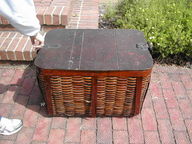
Stationary (with some rough sketches of unknown content) exists, listing
George II as president.


 According to
[GG2Mem],
George became acquanted with Joseph Tausch in 1909, who was working for the
Cyclone Fence Co. at the time. Cyclone was making fencing, but not gates;
George and Joseph formed the Gorton Fence Co., of Waukegan, IL. in 1915 or 1916.
with the intention of complementing the fences with gates.
Some of the stock certificates from that venture
have survived, as have some of the patents, the march, 1917 inventory,
tax forms, and some of the notes regarding the incorporation of the business.
Some of the stock certificates are from October 1918, which is presumably before
the liquidation of the company.
According to
[GG2Mem],
George became acquanted with Joseph Tausch in 1909, who was working for the
Cyclone Fence Co. at the time. Cyclone was making fencing, but not gates;
George and Joseph formed the Gorton Fence Co., of Waukegan, IL. in 1915 or 1916.
with the intention of complementing the fences with gates.
Some of the stock certificates from that venture
have survived, as have some of the patents, the march, 1917 inventory,
tax forms, and some of the notes regarding the incorporation of the business.
Some of the stock certificates are from October 1918, which is presumably before
the liquidation of the company.
- A brochure about the company: "The Story of the Gorton Gate"

- Stock certificate numbers 3 (24 shares), 14 (20 shares), 16 (10 shares),
and 19 (12 shares)
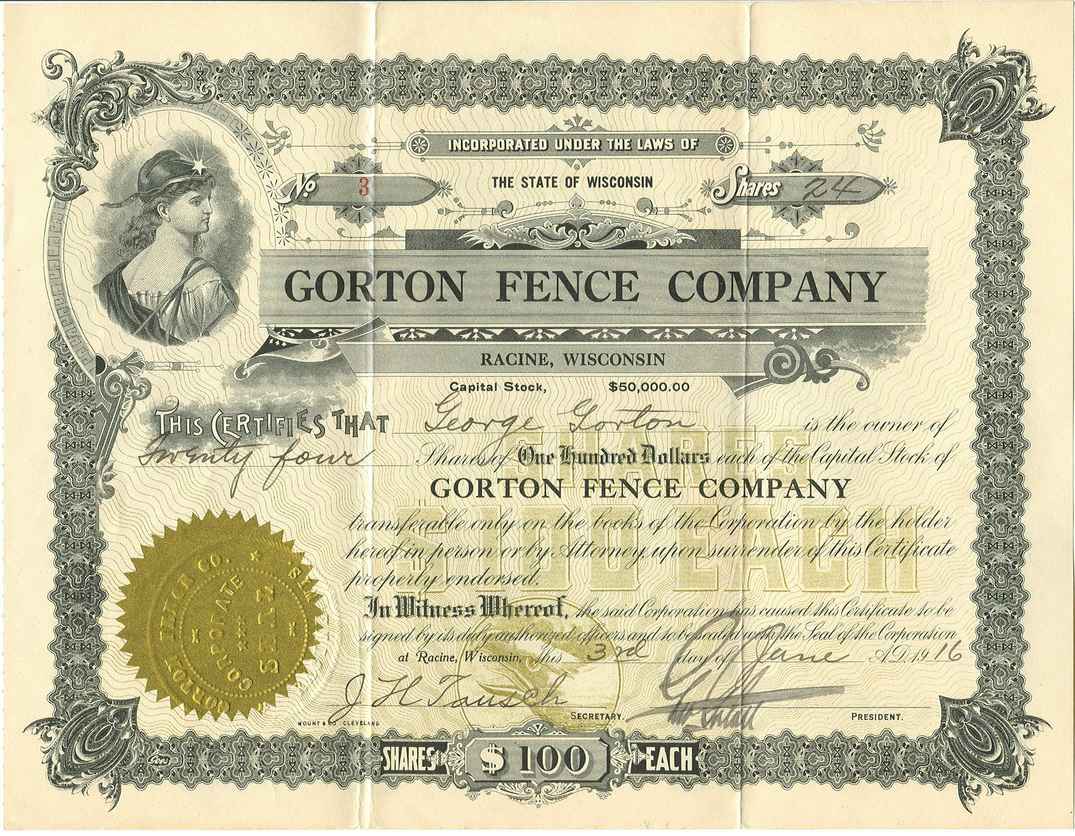
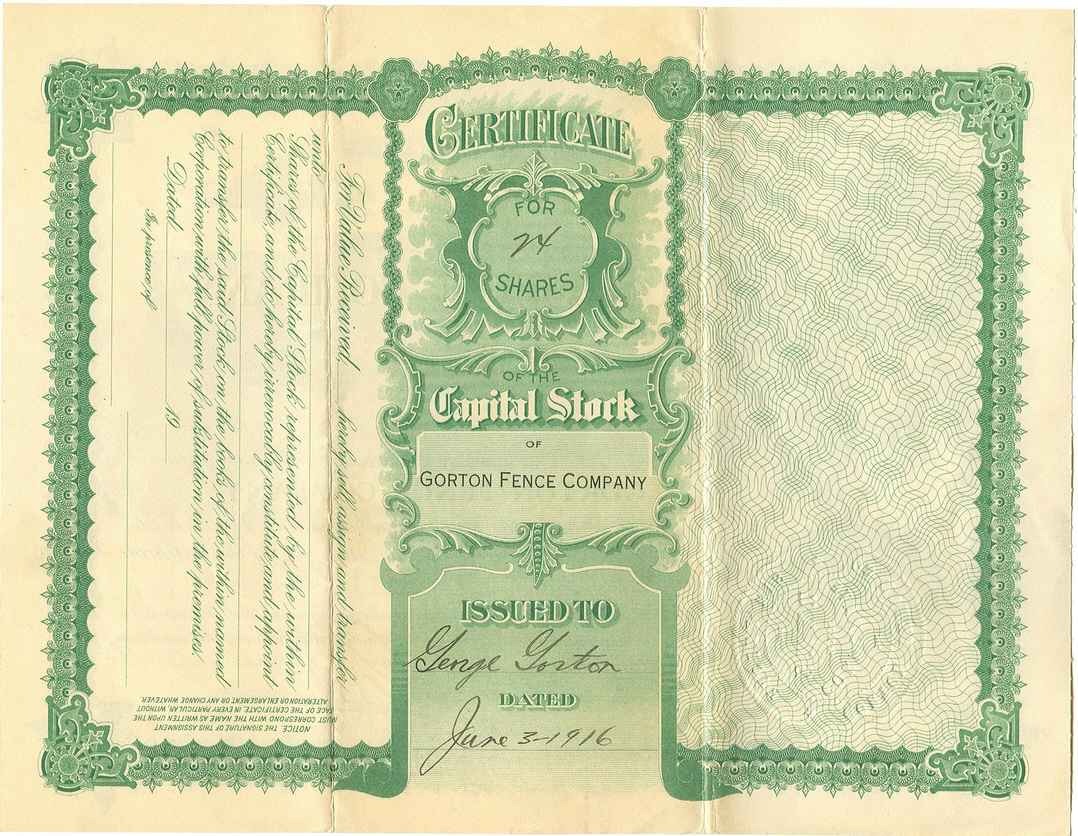
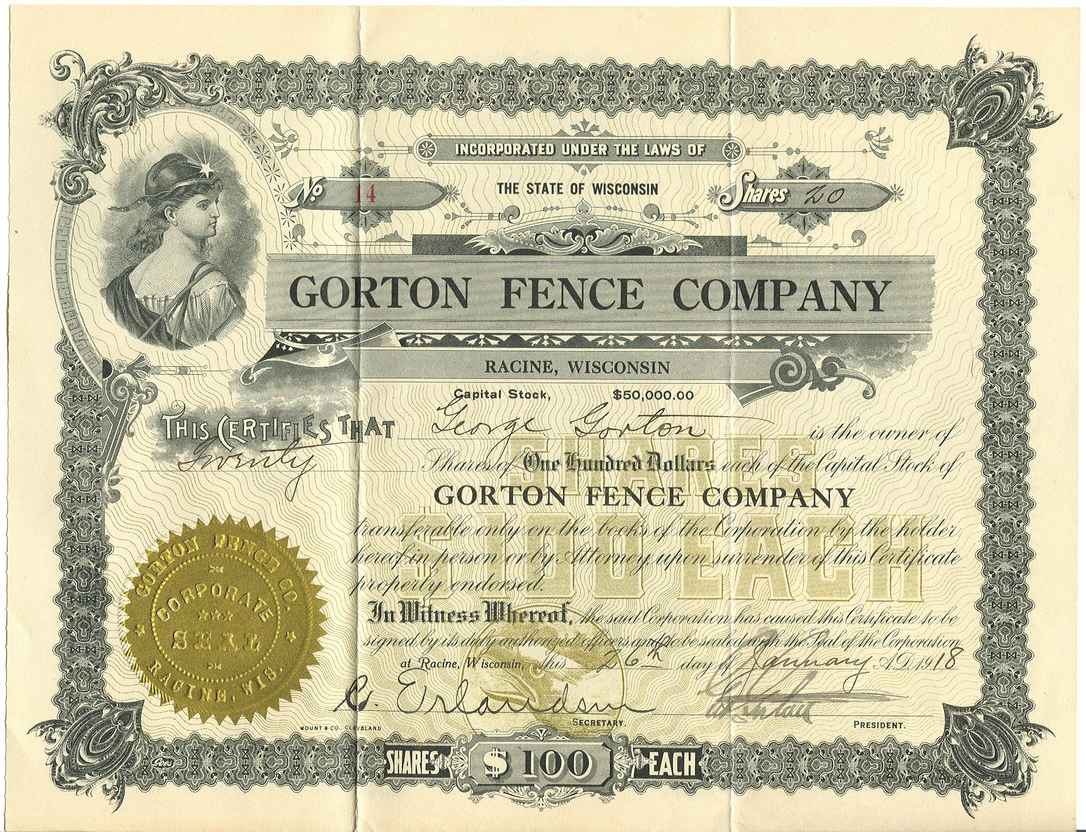
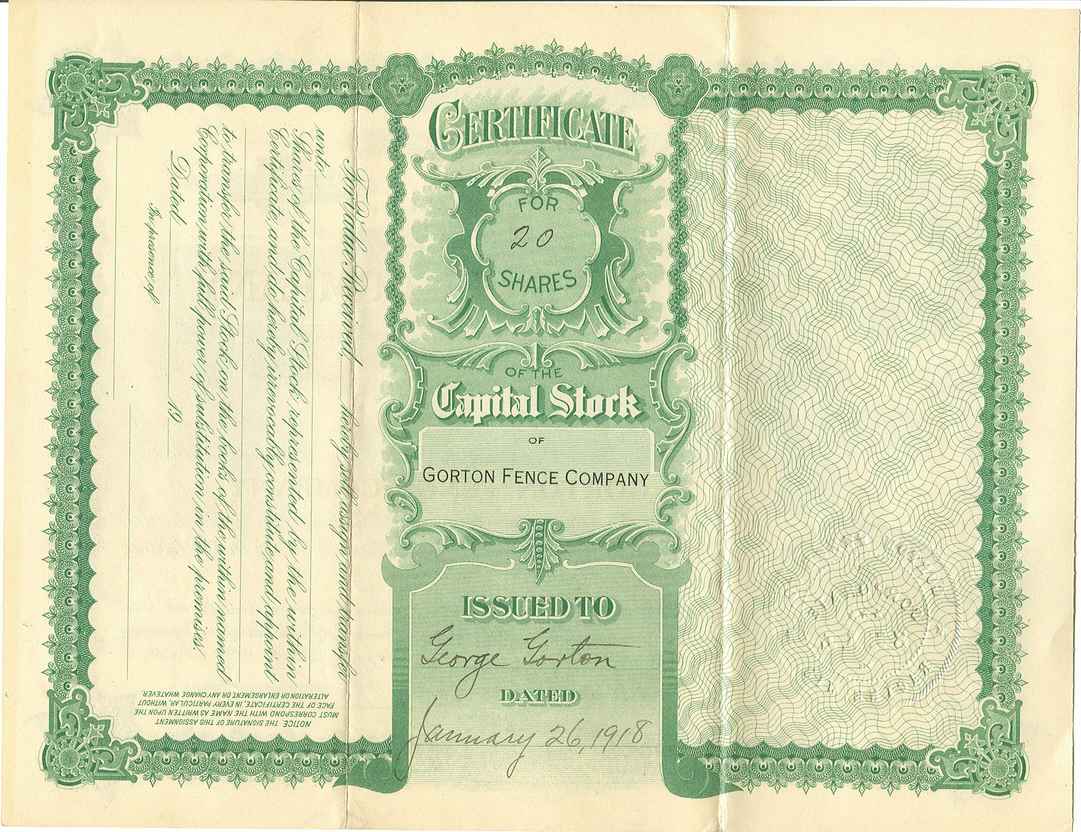
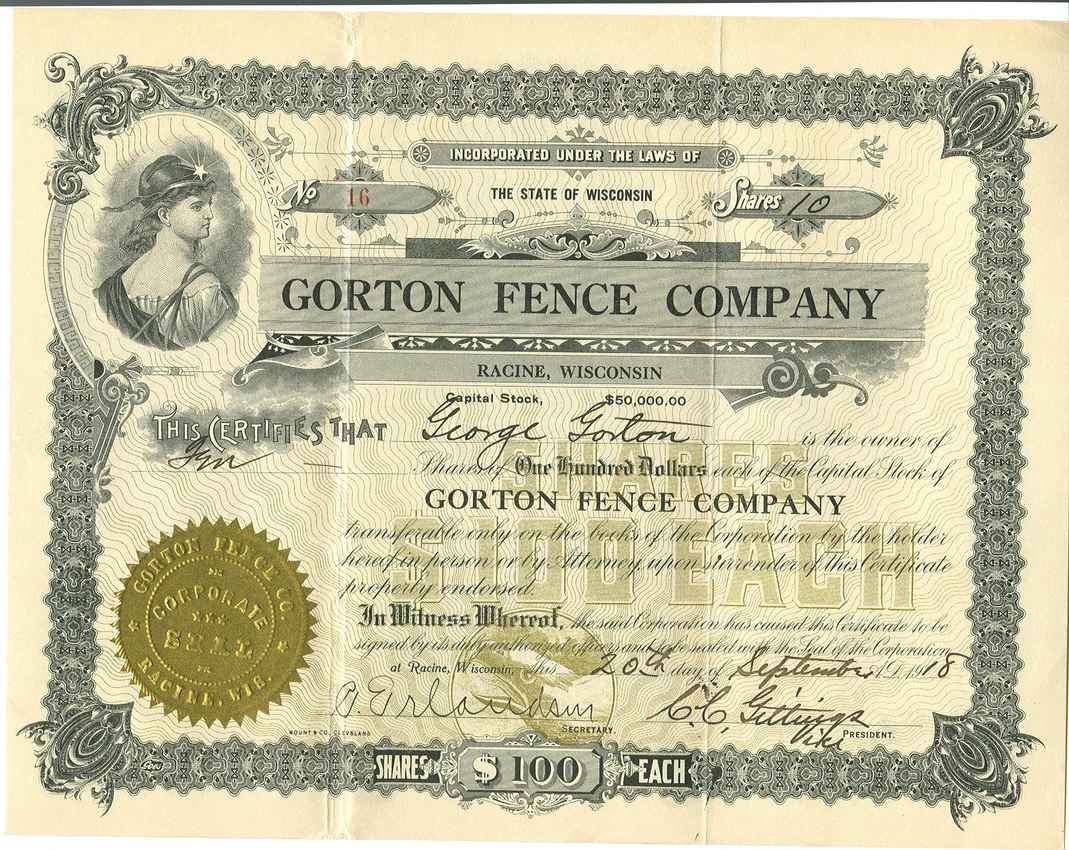
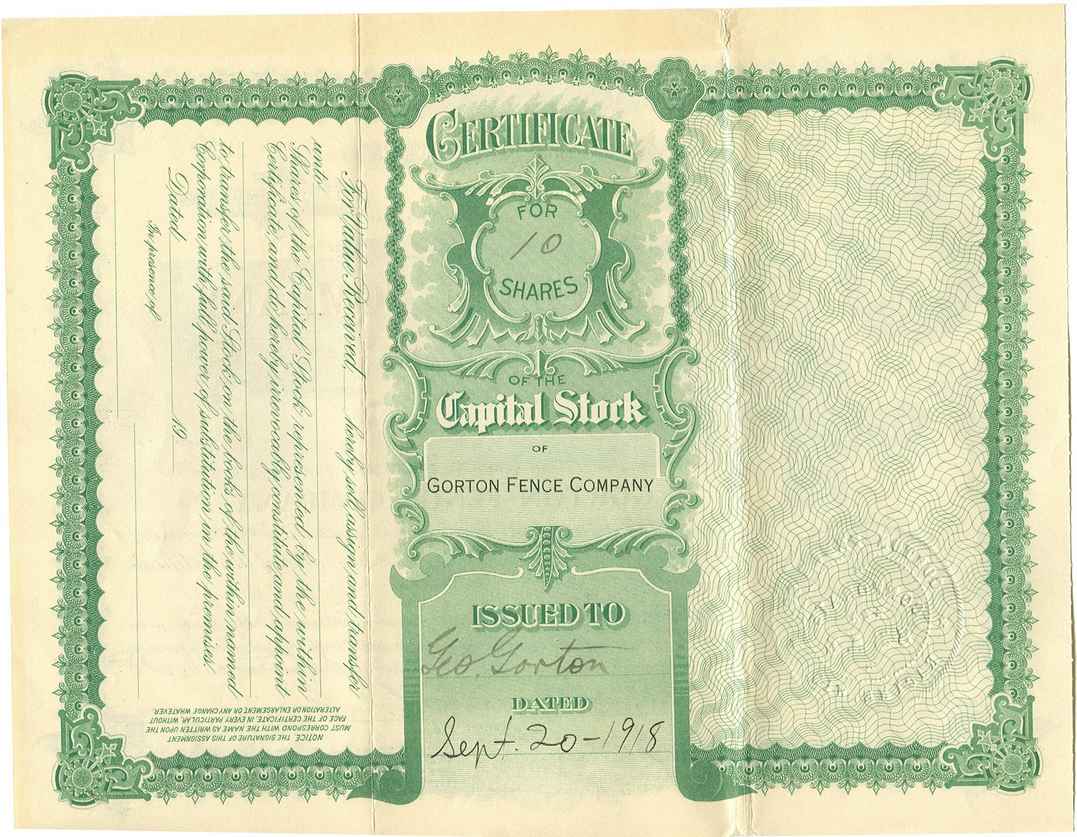
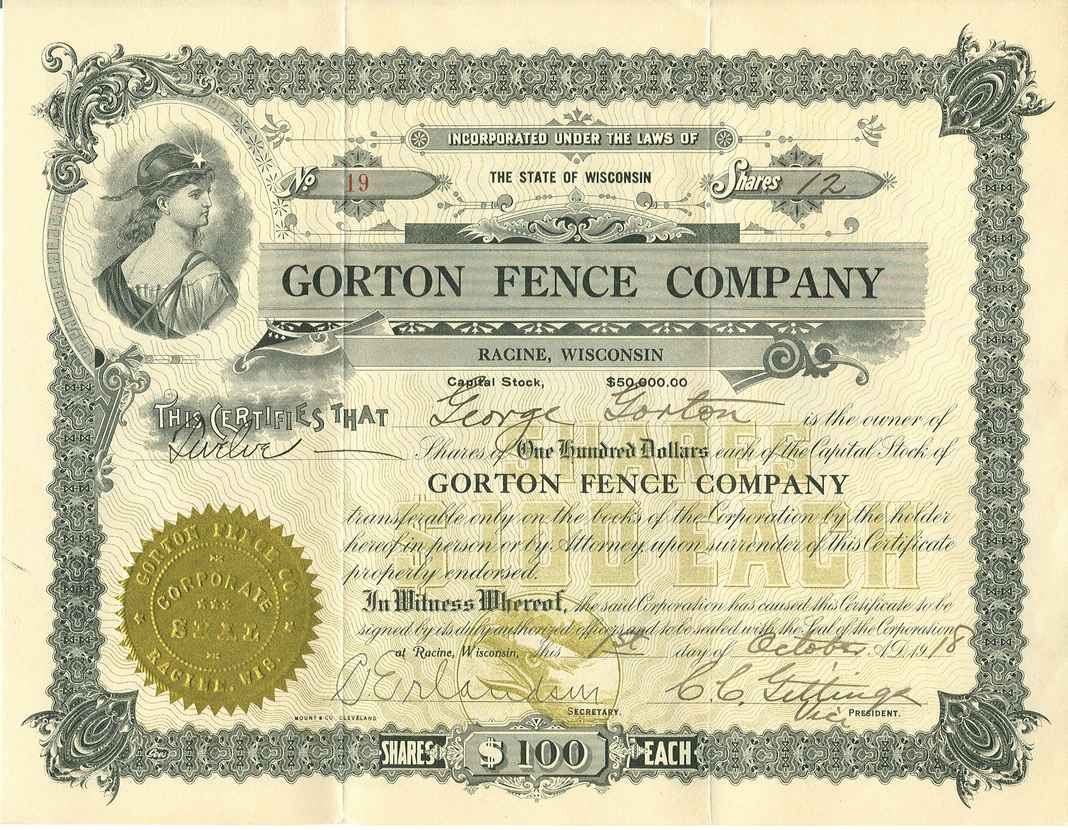
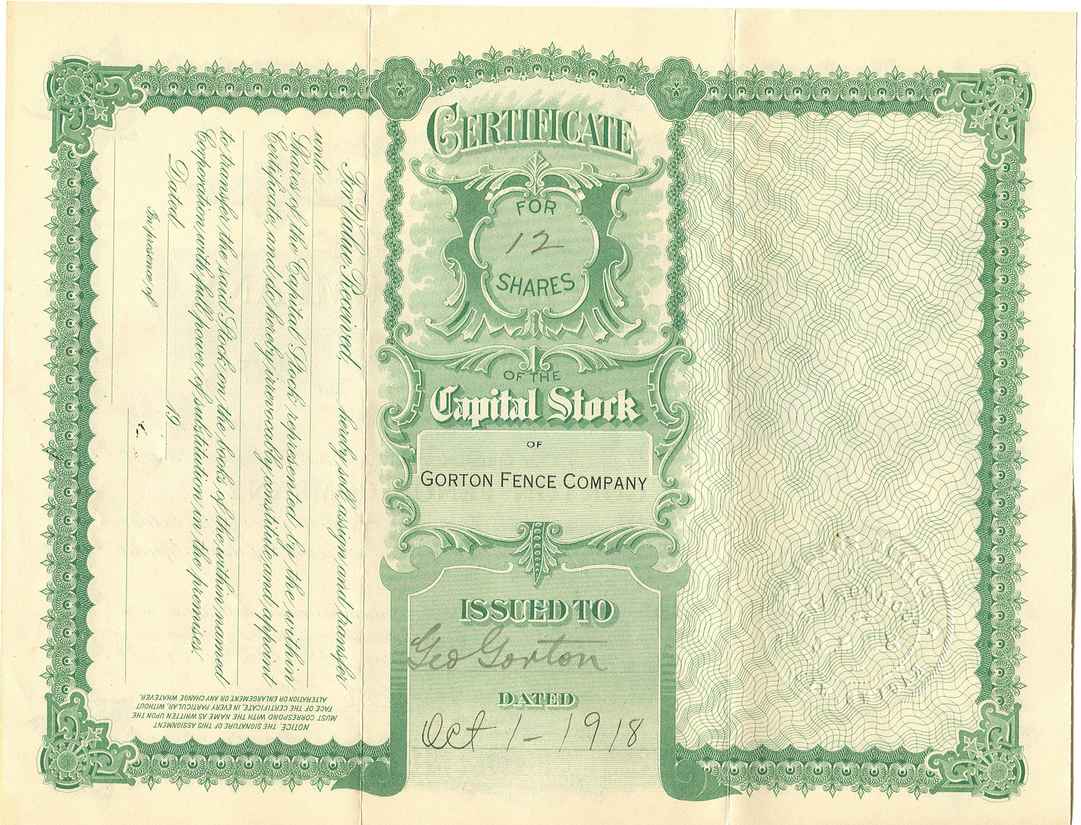
- Patents and patent assignment documents.
(A Patent is typically
assigned to the parties who own the rights to the patent. Frequently,
this is not the inventor.)
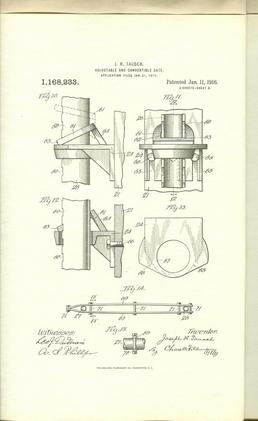
|
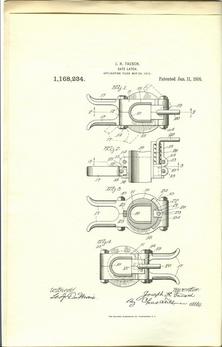
|

|

|
| US Patent 1168233 |
US Patent 1168234 |
US Patent 1168235 |
Canadian Patent 175720 |
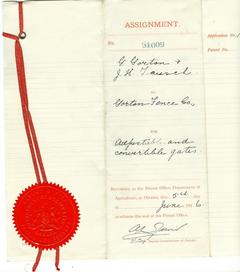
|
| Canadian patent assignments |
-
Accounting notes:
two balance statements from April, 1917 and
Gorton Fence Expenses of 1917
-
notes about how to set up the company
-
notes and memoranda regarding the
incorporation of Gorton Gate and Fence Co.
-
Inventory of the company as of march 1, 1917
-
The official record of a patent appeal
regarding the ownership of a patent for fence-weaving machines
-
Tax documents for Gorton Fence Co, 1917
-
Some US patent assignment documents:
Gate and Locking Means,
Gate-Latches,
Adjustable and Convertible Gates,
Fence [manufacturing] machines,
and an assigment from Fred Wright of Michigan for
patent on Gates.
-
 Like a great many people in the early 1900s, George II started investing in Oil,
believing that it would become more and more important in the years to come,
and that the investment would grow accordingly. He had been purchasing
stock in the Oklahoma Star Oil Company, of Cement, Oklahoma over the course
of a number of years; eventually, a 10-day vacation in 1917 from his hectic
schedule to visit the company turned into a roughly 10 year stay in Oklahoma,
resulting in the entire family relocating there for a number of years.
Overall, it appears (to this author) that financially, the oil investments were
a net loss. Litigation regarding the operation (and lack of profitability)
of the trust started in 1948, and continued until 1951.
Here are various documents regarding the trust.
Like a great many people in the early 1900s, George II started investing in Oil,
believing that it would become more and more important in the years to come,
and that the investment would grow accordingly. He had been purchasing
stock in the Oklahoma Star Oil Company, of Cement, Oklahoma over the course
of a number of years; eventually, a 10-day vacation in 1917 from his hectic
schedule to visit the company turned into a roughly 10 year stay in Oklahoma,
resulting in the entire family relocating there for a number of years.
Overall, it appears (to this author) that financially, the oil investments were
a net loss. Litigation regarding the operation (and lack of profitability)
of the trust started in 1948, and continued until 1951.
Here are various documents regarding the trust.

George II's unpublished memoirs also make mention of a joint venture to build a
machine which would fold, wrap, and address newspapers, magazines,
and other printed content. The factory was in Racine; there was an office
in Milwaukee at 85 Michigan St. The company eventually was liquidated,
but a sheet of stationery and a brochure about the company and an
insert photo have survived.





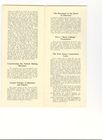
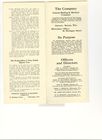
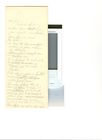
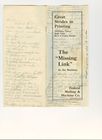
The cover and back have handwritten content which is rather hard to read.
Starting on the back:
"Dear Sir; -
Enclosed find matter that should have from closest investgation
Please bear in mind these facts - we have the only successful machine for
folding, wapping, and addressing -
"
That machine may be seen in operation and
We are prepared to "make good" by
by operating the machine in
showing you the machine in [Unknown, probably 'operation']
Facts only are given in pamphlet enclosd so taht you may
can [Unknown struck word] readily prove same.
The men behind this Co. have reputations to keep, and are
personallyeach giving much valuable time to the Federal Co.
without pay - doing all possible No [Unknown]
are permitted in any way with our [Unknown].
The officers are selling its stock.
[front cover]Several of us [Unknown] into this
thing, as heavily as [Unknown] the fact few years = We
believe it in the opportunity of a lifetime and sholud be glad to have you
purchase as much or as little stock as you wish as the officers
controls ourwill [Unknown] you need
[Unknown] large interest gaining
[Unknown] you out. (Succesfully) and at
[Unknown] extreme - Every dollar you may find in
[Unknown] counts for you.
If therefore
[Unknown] have a tool we claim (and facts are given you so you
[Unknown] from it) you can readily figure what the
[Unknown...] If in doubt ask any large publisher
what it means if we are to do accomplish by machine
whether the [Unknown] machine as [Unknown]
Along the edge of the cover it says: "Had Pat. on picking up sheets by suction."
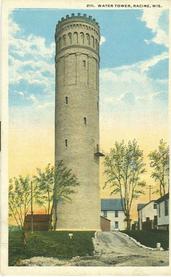 Fred Graham and George remained good friends over the years; Fred joined the family
contracting business. In 1897, the town of Racine put out bids to enclose a 330,000
gallon standpipe in brick; Fred asked George to design the building for him.
George did, and much to his surprise, Fred won the bid. The tower was located
just east of the Northwestern Railroad, and north of Tenth St. By the late 1940's,
the structure was being used as a police radio tower. At least one of the volunteers
at the
Racine Heritage Museum
remembers the water tower.
Fred Graham and George remained good friends over the years; Fred joined the family
contracting business. In 1897, the town of Racine put out bids to enclose a 330,000
gallon standpipe in brick; Fred asked George to design the building for him.
George did, and much to his surprise, Fred won the bid. The tower was located
just east of the Northwestern Railroad, and north of Tenth St. By the late 1940's,
the structure was being used as a police radio tower. At least one of the volunteers
at the
Racine Heritage Museum
remembers the water tower.
Fred later approached George to design a smokestack for a new smokestack for the
Racine Power Plant; again the combination of Fred's bid and George's design won the
project.
There seem to also have been various forays into the building of
combustion engines; from a prototypes for automobiles, to prototypes of
"planters' engines" for farm use, to a Gnome-style radial aircraft engine
(for the J.I. Case company)
Among the documents which still exist, there is a large envelope filled with
copies of various patents related to packing-house operations, food extruding,
presses, cream separation, etc. The envelope is addressed to Mr. George Gorton,
Cement Oklahoma. Why these were of interest to George II is a mystery, but
he certainly was interested enough in the field to look at 25 patents;
curiously, all of the inventions are by John J. Berrigan of Orange,
New Jersey.
In 1910 or 1911, the J.I. Case company, which owned the Pierce Motor Company,
decided to enter cars for the Indianapolis Speedway races. In his unpublished memoirs,
George recorded that he was hired to manufacture two cars; one of these was driven
by Joe Jagersberger in the 1911 race.
Please contact me if you wish to use images or content herein
Copyright, 2004 - 2015 Richard Gorton - rcgorton@verizon.net














 Most of the information about Racine Basket comes from a few paragraphs in
[Port92] about George I, and
various hints from
[GG2mem].
The factory was located on 13th, 14th, Racine, and Clark Streets.
George I bought Racine Basket prior to 1878; after the works were destroyed
by fire in 1878, the factory was rebuilt in brick and stone.
George II worked at various positions with Racine Basket, including as
a traveling (via rail) salesman.
In June, 1888, George I died, with the net effect that George II had to take
over the operation of the Racine Basket Co, which employed roughly 200
people at the time.
A pair of photographs of Racine Basket employees likely exist: This first one is
not a sure thing, but some of the faces do match up with faces in the one that is
a known employee photo.
Most of the information about Racine Basket comes from a few paragraphs in
[Port92] about George I, and
various hints from
[GG2mem].
The factory was located on 13th, 14th, Racine, and Clark Streets.
George I bought Racine Basket prior to 1878; after the works were destroyed
by fire in 1878, the factory was rebuilt in brick and stone.
George II worked at various positions with Racine Basket, including as
a traveling (via rail) salesman.
In June, 1888, George I died, with the net effect that George II had to take
over the operation of the Racine Basket Co, which employed roughly 200
people at the time.
A pair of photographs of Racine Basket employees likely exist: This first one is
not a sure thing, but some of the faces do match up with faces in the one that is
a known employee photo.










 Like a great many people in the early 1900s, George II started investing in Oil,
believing that it would become more and more important in the years to come,
and that the investment would grow accordingly. He had been purchasing
stock in the Oklahoma Star Oil Company, of Cement, Oklahoma over the course
of a number of years; eventually, a 10-day vacation in 1917 from his hectic
schedule to visit the company turned into a roughly 10 year stay in Oklahoma,
resulting in the entire family relocating there for a number of years.
Overall, it appears (to this author) that financially, the oil investments were
a net loss. Litigation regarding the operation (and lack of profitability)
of the trust started in 1948, and continued until 1951.
Here are various documents regarding the trust.
Like a great many people in the early 1900s, George II started investing in Oil,
believing that it would become more and more important in the years to come,
and that the investment would grow accordingly. He had been purchasing
stock in the Oklahoma Star Oil Company, of Cement, Oklahoma over the course
of a number of years; eventually, a 10-day vacation in 1917 from his hectic
schedule to visit the company turned into a roughly 10 year stay in Oklahoma,
resulting in the entire family relocating there for a number of years.
Overall, it appears (to this author) that financially, the oil investments were
a net loss. Litigation regarding the operation (and lack of profitability)
of the trust started in 1948, and continued until 1951.
Here are various documents regarding the trust.










 Fred Graham and George remained good friends over the years; Fred joined the family
contracting business. In 1897, the town of Racine put out bids to enclose a 330,000
gallon standpipe in brick; Fred asked George to design the building for him.
George did, and much to his surprise, Fred won the bid. The tower was located
just east of the Northwestern Railroad, and north of Tenth St. By the late 1940's,
the structure was being used as a police radio tower. At least one of the volunteers
at the
Racine Heritage Museum
remembers the water tower.
Fred Graham and George remained good friends over the years; Fred joined the family
contracting business. In 1897, the town of Racine put out bids to enclose a 330,000
gallon standpipe in brick; Fred asked George to design the building for him.
George did, and much to his surprise, Fred won the bid. The tower was located
just east of the Northwestern Railroad, and north of Tenth St. By the late 1940's,
the structure was being used as a police radio tower. At least one of the volunteers
at the
Racine Heritage Museum
remembers the water tower.